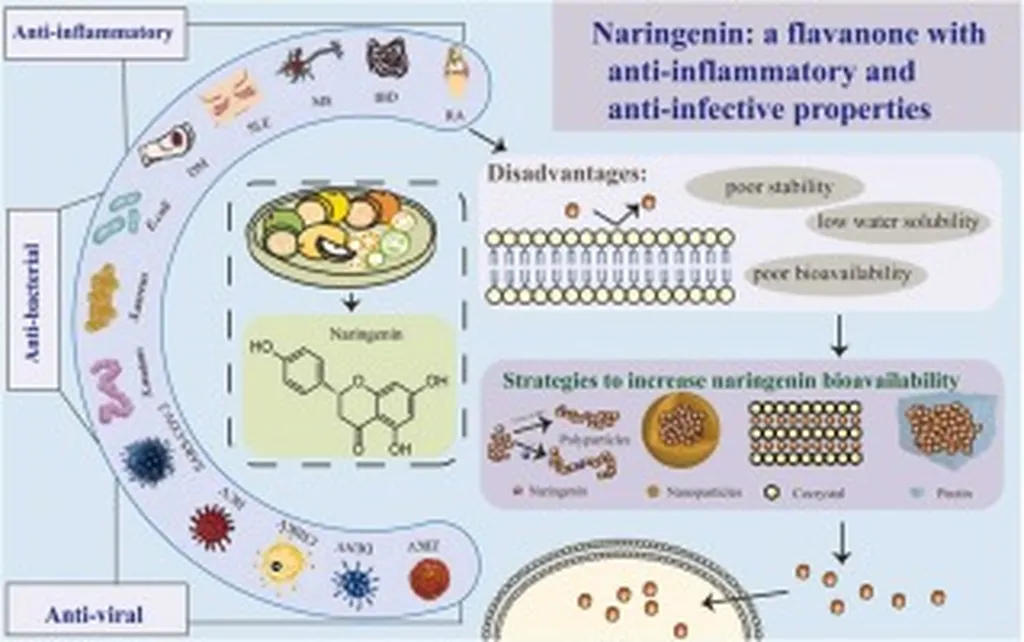In the realm of food science and technology, a groundbreaking study has emerged, shedding light on the potential of naringenin, a dietary polyphenol, to eliminate harmful compounds in foods. The research, led by Dr. WU Zhongjun from Jinan University in Guangzhou, China, and published in the journal ‘Shipin Kexue’ (which translates to ‘Food Science’), explores the mechanism by which naringenin interacts with methylglyoxal (MGO), a reactive carbonyl compound known for its role in the formation of advanced glycation end products (AGEs).
AGEs are implicated in various health issues, including diabetes and aging, making the elimination of MGO a significant public health concern. The study found that naringenin effectively eliminates MGO and inhibits the formation of AGEs under simulated physiological conditions. “After 24 hours, the elimination rate of MGO reached 47.90%, and the inhibition rate of AGEs reached 69.70%,” reported Dr. WU. This finding suggests that naringenin could be a powerful tool in the fight against AGEs and their associated health risks.
The research team delved deeper into the mechanism of action, using high-performance liquid chromatography-mass spectrometry (HPLC-MS) and nuclear magnetic resonance (NMR) analysis. They discovered that naringenin interacts with MGO to form two isomeric adducts, named 8-(1-hydroxyacetone)-naringenin. This interaction not only eliminates MGO but also forms stable compounds that are less harmful than MGO itself.
To assess the practical applications of these findings, the researchers developed a method to determine the adducts in foods. They found that in thermally processed foods like biscuits, naringenin effectively eliminates MGO by forming these adducts. “At the maximum addition level of 1.0 g/kg, the elimination rate of MGO was 70%, and the content of the adducts was 47.44 mg/kg,” explained Dr. WU. This indicates that naringenin could be added to foods during processing to reduce the levels of harmful compounds.
The study also evaluated the cytotoxicity of the adducts against human gastric, intestinal, and liver cells. The results were promising, as the adducts showed cytotoxicity levels similar to those of naringenin itself. This suggests that the adducts formed by the interaction of naringenin and MGO are not only less harmful than MGO but also pose minimal additional health risks.
The implications of this research are far-reaching. Naringenin, a naturally occurring compound found in citrus fruits, could be harnessed to improve food safety and quality. Its ability to eliminate MGO and inhibit AGEs formation makes it a valuable addition to the food industry’s arsenal against harmful compounds. Moreover, the findings could pave the way for the development of new food additives and functional foods designed to promote health and prevent disease.
Dr. WU and his team’s work is a testament to the power of scientific inquiry and innovation. Their research not only advances our understanding of the interactions between dietary compounds and harmful substances but also opens up new avenues for the application of these findings in the food industry. As we continue to grapple with the challenges of food safety and public health, studies like this offer hope for a healthier future.
The research was conducted by a multidisciplinary team from various institutions, including the State Key Laboratory of Bioactive Molecules and Druggability Assessment at Jinan University, the College of Life Science and Technology at Jinan University, the Shenzhen Agricultural Products Quality and Safety Inspection and Testing Center, Guangzhou Wobang Biotechnology Co. Ltd., and the Health Nutrition Baking Food Research and Development Engineering Technology Research Center at Guangzhou College of Technology and Business. This collaborative effort underscores the importance of interdisciplinary research in addressing complex scientific and technological challenges.
As the food industry continues to evolve, the integration of scientific research into food processing and production practices will be crucial. The findings of this study could inspire new approaches to food safety and quality control, ultimately benefiting consumers and the industry alike. The journey towards a healthier, safer food supply is ongoing, and research like this is a significant step in the right direction.

